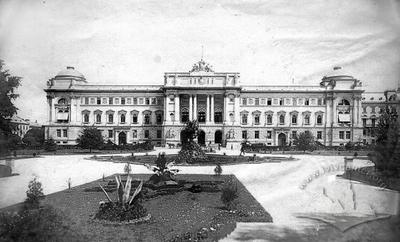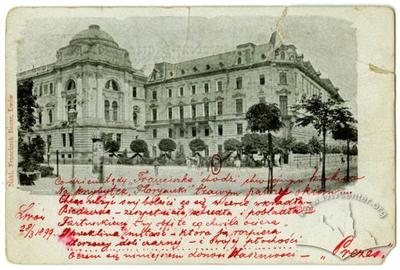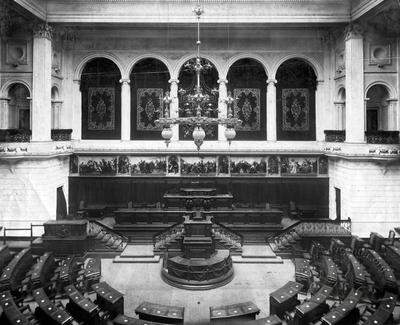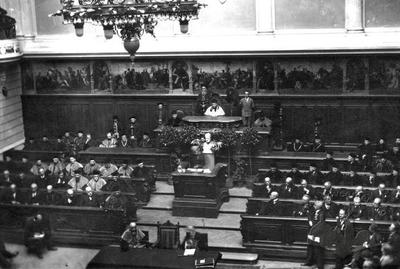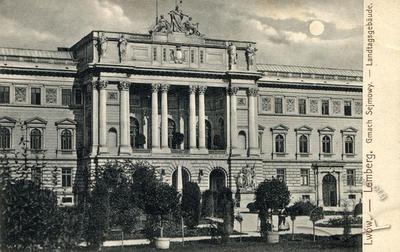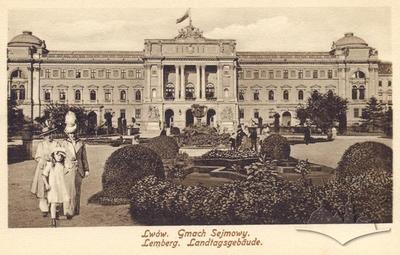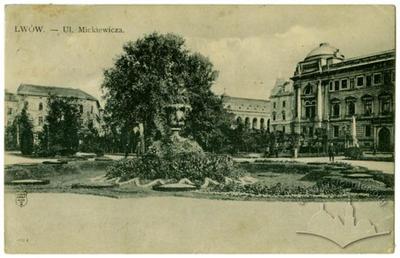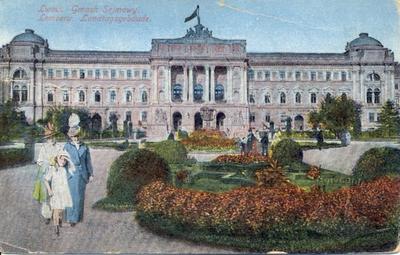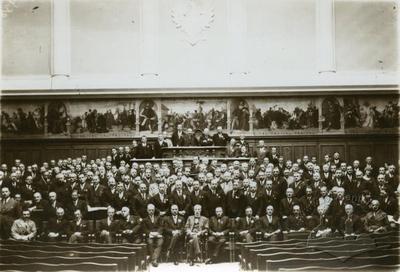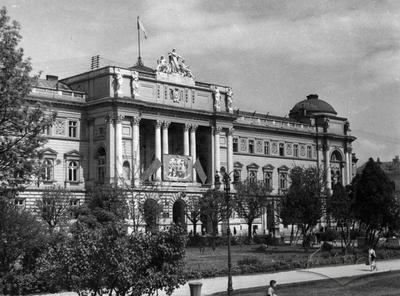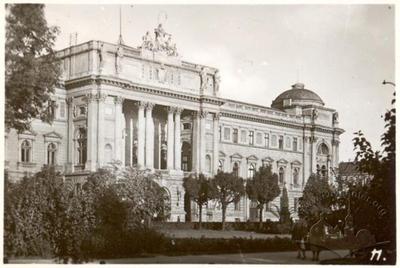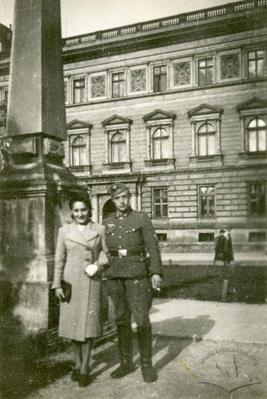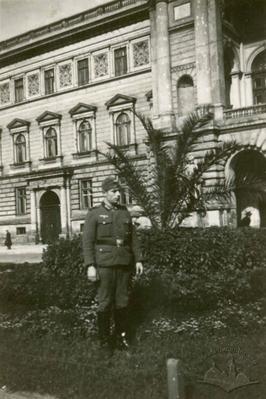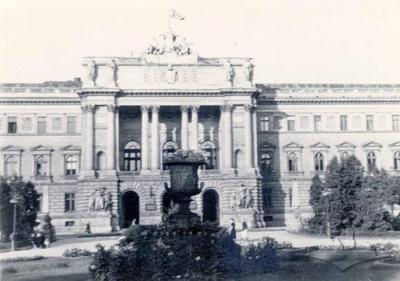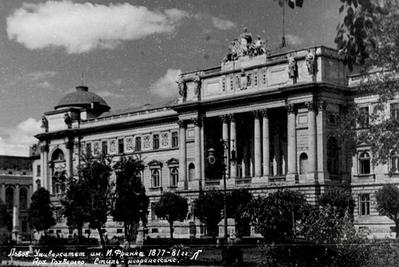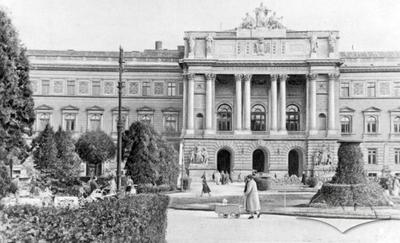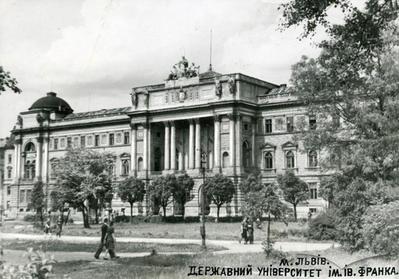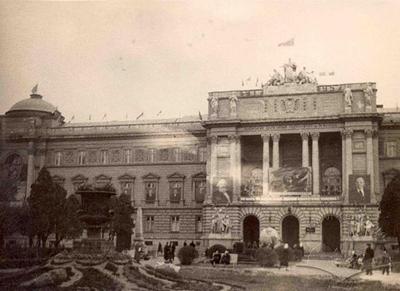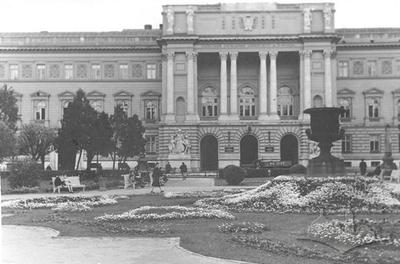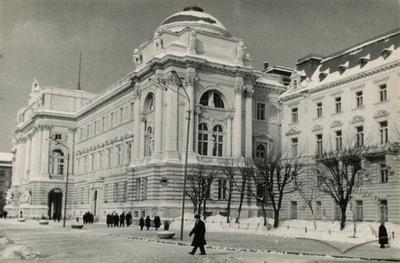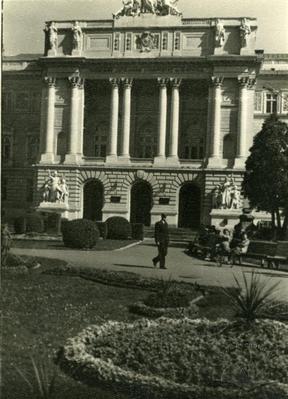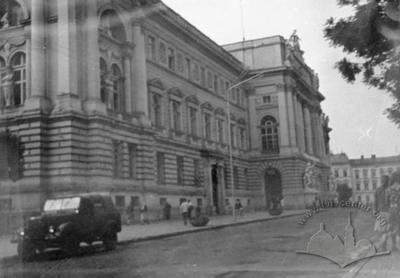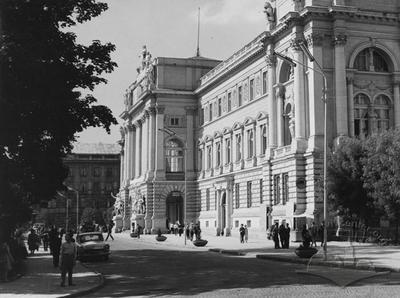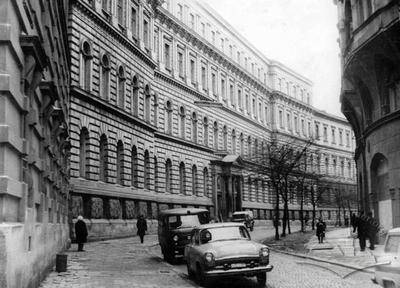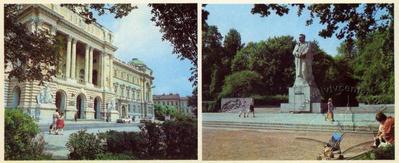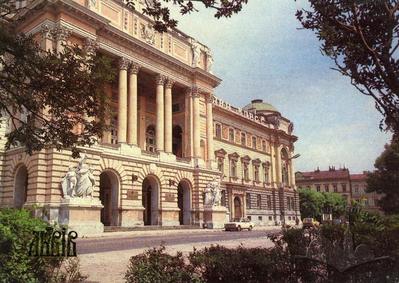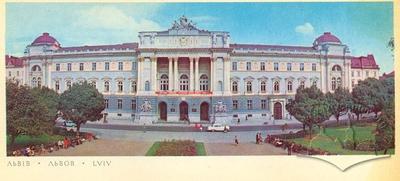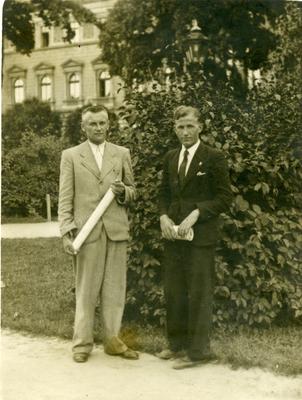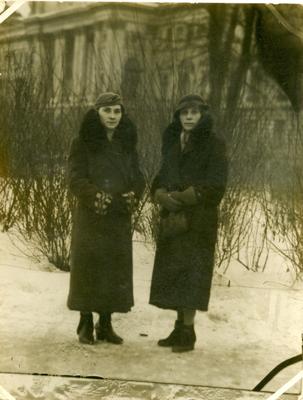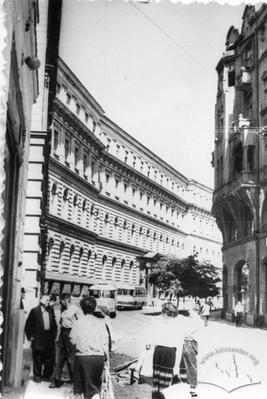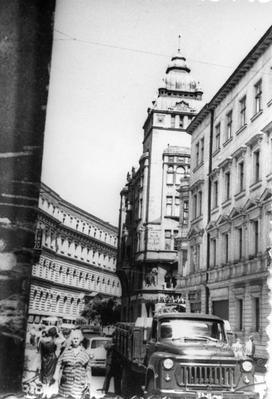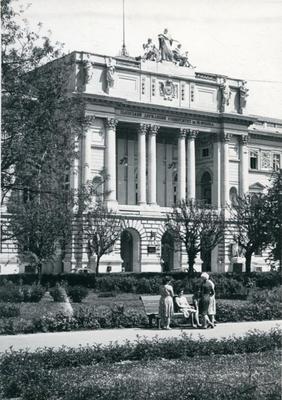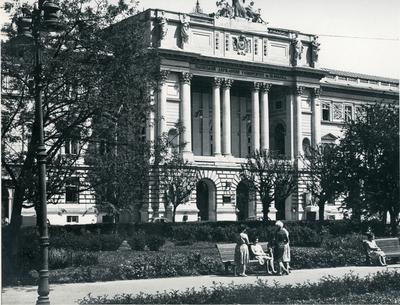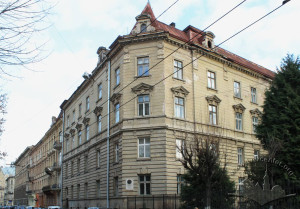Vul. Universytetska, 1 – Lviv Ivan Franko National University main building ID: 293
The former Galician Sejm building (now the main building of the Lviv National Ivan Franko University) was constructed in 1877-1881 under a project designed by architect Juliusz Hochberger. The monumental Sejm building belongs to the Historicist style influenced by the Vienna Neo-Renaissance architecture of the second half of the 19th century; it is notable for its rich sculpture and ornamental decorations.
Story
The idea to erect a special building for the Galician Sejm (or, officially, the Diet of Galicia and Lodomeria) and for the Provincial Department, the Sejm's executive body, was born in the course of sharp debate on the issue of the Galician autonomy between Polish politicians and the Austrian government. The project was inspired by Leon Sapieha, the Sejm marshal, commissioned by the Provincial Department and designed by Juliusz Hochberger, the city building administration director, in 1876-1877.Earth works, which were a part of the Galician Sejm building construction, were started on 1 April 1878. Half a year later, on 29 September 1878, the building's cornerstone was solemnly laid. The main works were finished in the summer of 1881. The building was consecrated on 23 July of the same year; a regular session of the Sejm started there two months later.
In 1906-1907 a fourth floor was added by architect Alfred Kamienobrodzki who also expanded the building (a lateral wing was build from the side of what is now Lystopadovoho Chynu street).
The Galician Sejm was located in the building till 1914. After the Polish Jan Kazimierz University was transferred to the former Sejm building, the assembly hall was reconstructed and adapted for the University's needs. The hall was ruined during the World War II and restored in 1950.
The Lviv National Ivan Franko University (or the University of Lviv) is one of the oldest universities in Ukraine. It was founded on 20 January 1661, when king Jan III Sobieski conferred the title of university on the Jesuit college. Jesuits ran the University till 1773 when the order was suspended. In 1784 Emperor Joseph II signed a diploma on the restoration of the University. The language of teaching was Latin. The University was located in the former Trinitarian monastery on Krakivska street (now the church of the Transfiguration of Our Lord Jesus Christ stands in its place). In 1787 the Studium Ruthenum institute, where students were taught in Ukrainian, was founded at the Lviv University.
In 1805 the Lviv University was turned into a lyceum by the Austrian government; in 1817 the university status was restored, but the language of teaching was German from that time on. In 1848, with the Spring of the Nations, the struggle for the introduction of the Polish and Ukrainian languages at the University started. In 1849 a department of the Ukrainian language and literature was created and headed by Yakiv Holovatsky.
After the post-Trinitarian university buildings were bombarded by the Austrian army in 1848, the University was located in the former Jesuit convict's building (constructed in 1844) on the modern Hrushevskoho street from 1851. Shortly, however, the building was not meeting the academic needs. That is why a building for the chemistry, geology-mineralogy and pharmacology institutes was constructed on the modern Kyryla i Metodiya street in 1890-1891. Later, in 1897, another building was constructed for the physics institute; philosophical faculty’s departments as well as those of experimental physics, mathematics, geography were located there too. In 1905 a new building of the University library was constructed (Drahomanova street).
After Western Ukraine was incorporated into the Ukrainian SSR in 1939, the Lviv University was reorganized; in particular, the theological faculty was abolished while the medical faculty was transformed into a separate medical institute.
Architecture
The building is situated on an irregularly shaped plot limited by Universytetska, Sichovykh Striltsiv, Kostiushka and Lystopadovoho Chynu streets and located in front of the Ivan Franko park. This is the architectural dominant of the block.The University is a complicated three-storied building close to a pentagon in plan. It has three courtyards, a high base and a mansard roof. The main façade facing the park is designed in the Neo-Renaissance style with a noticeable influence of the contemporary Vienna palace architecture. It has one central and two lateral avants-corps decorated according to the order system, including avants-corps decorated with Corinthian order columns and pilasters.
Front stairs with a lobby and main premises of the former Sejm are located in the central part of the building next to the main entrance. The main six-flight stairs were used by deputies who entered the building through the main entrance from Universytetska street. These stairs and a gallery around them provided communication between the Sejm assembly hall, its premises and offices of the Provincial Department.
Under the front staircase of the main building, wardrobes were located. The stairs, hewn of Terebovlia stone, were lit through a skylight made of metal and glass.
According to the original project of the building, the Provincial Sejm's assembly hall could accommodate 230 deputies. Chairs were placed in a semicircle in the hall; they stood in tiers, like in an amphitheater, and were divided by passages along the circle rays. On a platform located at the front wall the marshal's chair stood; places for four Sejm secretaries were arranged on both sides of the platform below. There was a rostrum for speakers in front of the marshal's chair, with stenographers in front of it. Chairs for the government commissioner and three Sejm aides stood nearby.
The hall was lit by kerosene lamps in the evening. It was here that electric light was lit for the first time in Ukraine on 14 June 1881, on the initiative of engineers Roman Gostkowski and Franciszek Rychnowski.
The building's sculptural decoration was one of the richest among those Lviv buildings which were erected during the autonomy period (1871-1914). Most famous Lviv craftsmen were engaged in its construction as well as sculptors who worked outside of Galicia at that time, including Leonard Marconi, Teodor Rygier, Tadeusz Barącz, Zygmunt Trembecki, Feliks Mikulski, Zygmunt Gorgolewski.
The interior artistic decoration includes a plastic design of the staircase, conference hall and assembly hall. On both sides of the building’s central axis at the level of the gallery situated in front of the assembly hall, there used to be two sculptural groups created by Zygmunt Trembecki. These groups depicted four ancient rulers of Poland and Rus' (Ruthenia): princes Mieszko I and Volodymyr the Great, who established Christianity in their lands, as well as king Casimir the Great and prince Yaroslav the Wise. These sculptures disappeared during the World War II or immediately thereafter.
The Neo-Renaissance décor of the staircase and of the Sejm assembly hall was designed by sculptor Leonard Marconi (1880). The assembly hall's décor has been changed significantly. It was reconstructed under a 1920 project in 1923 and again in the 1950s. The university lobby walls are covered with murals in the style of that time.
The most showy premises of the building were located on the second floor. Apart from representative rooms, the Provincial Sejm assembly hall and the so-called "Marshal's Hall" were located there. The assembly hall was decorated with a painting entitled "The Union of Lublin", while that of the marshals (chairmen of the parliament) had a painting named "The Constitution of 3 May 1791" hanging on one of the walls. Both paintings were created by Jan Matejko, a famous Polish painter, and are kept in Warsaw now. In the Marshal's Hall, there were also portraits of the Sejm marshals, including count Alfred Potocki, Mikołaj Zyblikiewicz, count Ludwik Wodzicki, Włodzimierz Dzieduszycki, prince Leon Sapieha, and count Stanisław Badeni. The authors of the portraits were artists Jan Matejko, Henryk Siemiradzki, Kazimierz Pochwalski.
The main sculptural group (in the composition located above the attic on the main façade), entitled "The Guardian Spirit of Galicia", was created by sculptor Teodor Rygier in Italy in 1880-1881. In the center of the composition, there is an allegorical female figure, Galicia, who stretches her hands to the personifications of the Dniester and the Vistula, the "Ruthenian man" and the "Masurian woman", placed on both sides. This sculptural group played an important ideological role, indicating functionality of this government and administration building. In addition, Teodor Rygier is the author of two allegorical sculptures in front of the entrance, symbolizing education and work. For the allegorical groups on the attic and in front of the entrance he was made an honorary member of the Florence Academy of Art. Statues, placed directly in front of the avant-corps attic, are notable for their traditional academic art nature. They were created by Zygmunt Trembecki and Felix Mikulski. The former made statues symbolizing Faith and Justice, while the latter those symbolizing Education and Labor. Nine lions around the building's crown, holding shields with the coats of arms of cities and towns situated in the province of Galicia (most coats of arms were destroyed in the post-war years), may have been made by Tadeusz Barącz.
An art collection, which used to be a part of the Sejm premises decorations, was partially moved to Poland after the Sejm ceased to function and partially lost after 1941.
Related buildings and spaces
People
Leonard Marconi
– Leonard Marconi was a sculptor
and building
decorator, professor at the Higher Technical School in
Lviv.
Adolf Beck
– Professor, doctor of physiology.
Tadeusz Boy-Żeleński
– Polish writer, translator, publicist.
Tadeusz Hollender
– Polish writer.
Karol Kuryluk
– Polish journalist, publisher, cultural figure.
Denys Lukiyanovych
– Ukrainian writer and pedagogist.
Mykhaylo Rudnytskyi (1889–1975)
– Ukrainian literary scholar, critic, essayist, journalist, writer,
translator, and teacher.
Ostap Tarnavskyi (1917–1992)
– Ukrainian poet, translator, critic, literary scholar.
Vasyl Tkachuk
– Ukrainian writer.
Stepan Tudor (1892–1941)
– Ukrainian writer, literary critic, publicist, philosopher and
political figure.
Mykhaylo Vozniak (1881–1954)
– Ukrainian literary scholar.
Stanisław Kulczyński
– Polish botanist, politician, professor at the Jan Kazimierz University in Lviv and at the University of Wroclaw.
Yulian Lavrivskyi
– Ukrainian
political and cultural figure, judge, Galician Diet member and its vice-marshal,
member of the Ruthenian Congress, Congress of Ruthenian Scholars, organizer of
the Ruska Besida society and its theater, head of the Prosvita.
/* Style Definitions */
table.MsoNormalTable
Godzimir Małachowski
– Polish lawyer, politician, Deputy of Halychyna Parliament and the Austrian Parliament, President of Lviv (1896-1905).
Yevhen Olesnytskyi
– Leading Galician politician of Ukrainian (Ruthenian) origin, advocate, economist, journalist and translator.
Oleksandr Barvinsky
– A Ukrainian conservative
politician, educator and historian.
Sylvestr Sembratovych
– A Ukrainian church figure, Metropolitan of the Greek Catholic Church.
Raphael Lemkin
– Rafał (Raphael) Lemkin (1900-1959) is by now the most prominent Polish lawyer of the 20th century, widely known for his investment in conceiving the linguistic and legal terms appropriate for what due to his efforts has become common currency under the expression genocide.
Hersch Lauterpacht
– Sir Hersch Lauterpacht
(1897–1960) is considered one of the most influential
international legalists of the twentieth century, if not the founder of modern
international law, due to his remarkable contributions to the foundation of the
international protection of human rights after 1945.
Ivan Stupnytskyi
– Fr. Ivan Stupnytskyi is an example of an
intellectual for whom, despite his religious rank, studies in numismatics and
archeology did not have a clearly religious basis, being rather a pleasure at leisure, which his education and high
social position allowed him. Chancellor of the Greek Catholic Church, bishop of
Przemyśl and deputy marshal of the Galician Diet, he also was a correspondent of the Viennese Central Commission for the
Protection of Monuments in 1866-1890.
Badeni, Stanisław (1850-1912) – Polish noble, the Galician Sejm marshal in 1895-1901, and in 1903-1912Barącz, Tadeusz (1849-1905) – famous Lviv sculptor of Armenian origin
Dzieduszycki, Włodzimierz (1825-1899) – Polish noble, the Galician Sejm marshal in 1895-1899
Gorgolewski, Zygmunt (1845-1903) – architect
Gostkowski, Roman (1837-1912 – Polish noble, engineer
Hochberger, Juliusz (1840-1905) – architect, the city building administration director
Holovatsky, Yakiv (1814-1888) – noted Ukrainian historian, linguist
Jan III Sobieski (1629-1696) – king of Poland in 1674-1696
Kamienobrodzki, Alfred (1844-1922) – famous Lviv architect
Matejko, Jan (1838-1893) – famous Polish painter
Mikulski, Feliks (1853-1886) – sculptor
Pochwalski, Kazimierz (1855-1940) – famous Polish painter
Potocki, Alfred (1817/1822-1889) – Polish noble, the Galician Sejm marshal in 1875-1877
Rychnowski, Franciszek (1850-1929) – famous Lviv engineer and inventor
Rygier, Teodor (1841-1913) – famous Polish sculptor
Sapieha, Leon (1803-1878) – Polish noble, the first Galician Sejm marshal in 1861-1876
Siemiradzki, Henryk (1843-1902) – famous Polish artist
Trembecki, Zygmunt (1847-1922) – famous Polish artist and sculptor
Wodzicki, Ludwik (1834-1894) – Polish noble, the Galician Sejm marshal in 1877-1880
Zyblikiewicz, Mikołaj (1823-1887) – Polish noble, the Galician Sejm marshal in 1880-1886
Organizations
Sources
- State Archives of Lviv Oblast (DALO). 2/1/958
- DALO. 2/1/960.
- DALO. 2/1/968.
- DALO. 2/1/962.
- DALO. 2/1/974.
- Олена Аркуша, Мар'ян Мудрий, "З історії спорудження Галицького крайового сейму у Львові", Наукові зошити історичного факультету, вип. 4., (Львів, 2001), 133-144.
- Володимир Вуйцик, Роман Липка, Зустріч зі Львовом. Путівник, (Львів: Каменяр, 1987), 94.
- Львів. Туристичний путівник, (Львів: Центр Європи, 1999), 58-59.
- Борис Мельник, Довідник перейменувань вулиць і площ Львова, (Львів: Світ, 2001), 11.
- Mieczysław Orłowicz, Przewodnik po Lwowie, (Lwów, 1925), 95.
- Lwów. Ilustrowany przewodnik, (Lwów: Centrum Europy, Wrocław: Via Nova", 2001), 38.
Urban Media Archive Materials
